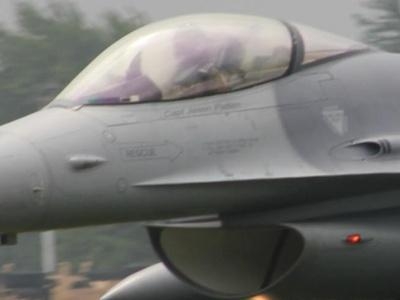Sat, Feb 25, 2012
Fogged Cockpit, Concern For Spectators Cited
The US Air Force has concluded its investigation into last
summer's incident at EAA AirVenture, in which an F-16 overran
runway 36 and headed 300 feet off into the grass. The report says
the jet's environmental control system (ECS) caused fogging that
obscured the pilot's vision, and resisted his efforts to clear the
canopy.

The Report adds the fogging (visible in photo from report) began
just as the pilot started his landing flare. It reads, in part, "As
the throttle was retarded to idle, fog began to envelope the entire
cockpit...he lost sight of the HUD gun-cross and was unable to use
the Nose Wheel Steering (NWS) indicator and AOA indexers for a
visual reference...
"Using the view out the side of the canopy, the MP focused on
keeping the aircraft tracking down the runway. The MP reached for
the DEFOG lever and shoved it full forward. He held it in that
position for one or two seconds with no effect and then recycled,
with yet again no change in ECS fog or airflow. The MP then
experienced brief vertigo, almost a tumbling sensation, and
considered ejection but was concerned for spectators and aircraft
along the runways. The MP did not consider initiating a go-around
because of the disorientation and no assurance that the ECS fog
would dissipate, rendering the MP blind while navigating through
the congested traffic pattern.
"The MP never saw the end of the runway approaching, but felt
that he had enough remaining runway to stop. Runway 36L has no
overrun or arresting gear. As the MA departed the runway surface,
the MP felt a bump and rumbling, and then the nose dug in. The ECS
fog cleared as the engine ingested dirt and sod."
At that point, the report adds, the nosewheel turned and broke
off and the nose contacted the ground, breaking off both the nose
and avionics bay, just forward of the cockpit bulkhead. The engine
intake ingested dirt and sod as the aircraft came to a stop.
Damage to the plane is estimated at 5-point-4-million dollars.
The unidentified pilot was assigned to the 100th Fighter Squadron,
187th Fighter Wing, based in Alabama.
More News
Airplane Bounced About 3 Ft Then Touched Back Down And Then, With No Brakes Applied, The Airplane Began Veering To The Left Analysis: The pilot entered the airport traffic pattern >[...]
Aero Linx: British Microlight Aircraft Association (BMAA) The primary focus within all aviation activity is SAFETY. In all aspects of our sport SAFETY must come first, whether it b>[...]
From SnF25 (YouTube Edition): William Wynne Builds Practical Aircraft Engines on the Corvair Platform Seeking an affordable alternative to the traditional aircraft engine options, >[...]
How To Get A Story On Aero-TV News/Feature Programming How do I submit a story idea or lead to Aero-TV? If you would like to submit a story idea or lead, please contact Jim Campbel>[...]
From 2023 (YouTube Edition): Bridge of CiES CiES Inc. is a Bend, Oregon-based designer and manufacturer of modular embedded aircraft systems and sensors. The company’s fuel-l>[...]
 NTSB Final Report: Aviat A1
NTSB Final Report: Aviat A1 ANN's Daily Aero-Linx (07.08.25)
ANN's Daily Aero-Linx (07.08.25) Classic Aero-TV: Fly Corvairs Reliable Engine Alternative
Classic Aero-TV: Fly Corvairs Reliable Engine Alternative ANN FAQ: Contributing To Aero-TV
ANN FAQ: Contributing To Aero-TV Classic Aero-TV: CiES Fuel-Quantity and e-Throttle Systems Praised
Classic Aero-TV: CiES Fuel-Quantity and e-Throttle Systems Praised



